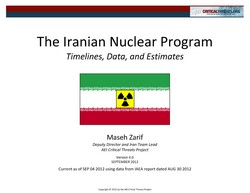{{currentView.title}}
September 04, 2012
The Iranian Nuclear Program: Timelines, Data, and Estimates V4.0
Iran is at the threshold of a nuclear weapons capability. Sanctions, direct action, and diplomatic tools have neither changed Iran’s nuclear policy nor had a visible effect on the enrichment program, including the growing stockpile of 19.75% LEU. Obtaining weapons-grade high-enriched uranium (HEU) is the most difficult and technically challenging obstacle to acquiring a nuclear weapon. Assessing the “breakout” time—the time required to convert low-enriched uranium (LEU) to weapons-grade HEU—is therefore a critical component of determining progress toward a nuclear weapons capability.
 |
AEI's Critical Threats Project has produced a capabilities-assessment of the time required for Iran to acquire enough weapons-grade uranium to fuel one nuclear weapon if it proceeds to break out in 2012. It does not assess Iran’s intentions to weaponize or to purse break-out scenarios, but rather focuses entirely on technical feasibility. The assessment also provides scenarios for the growth of Iran’s 19.75% LEU stockpile, background data on processes involved in a nuclear weapons program and Iran’s reported progress, and imagery of the primary enrichment facilities at Natanz and Fordow.
This product is an exposition of the technical data contained in numerous International Atomic Energy Agency (IAEA) reports informed by the discussions of experts in the field of nuclear proliferation. It is a work in progress in that it will be revised continuously based on new information from the IAEA reports and other sources and on feedback from readers. We welcome your informed commentary on the technical considerations presented in this document. Please send your comments, with references to source-date or documentation, to [email protected].
KEY FINDINGS
IRAN IS DEVELOPING A RAPID NUCLEAR WEAPONS BREAKOUT CAPABILITY BY REDUCING THE TIME IT NEEDS TO PRODUCE FUEL FOR AN ATOMIC WEAPON.
Iran would need 4.3 MONTHS to produce 25 kg of weapons-grade uranium and 1.9 MONTHS to produce 15 kg of weapons-grade uranium at the buried Fordow enrichment facility.* IT CAN CUT THESE TIMES SIGNIFICANTLY USING THE NEWLY INSTALLED CENTRIFUGES AT FORDOW.
Iran would need 3 WEEKS to produce 25 kg of weapons-grade uranium and 1 WEEK to produce 15 kg of weapons-grade uranium at the larger Natanz enrichment facility.*
These estimates are based on data from Iran’s declared operating facilities. The existence of undeclared (covert) enrichment sites, which cannot be ruled out given Iran’s record of deception, would have an impact on breakout estimates.
IRAN IS HARDENING ITS ENRICHMENT CAPACITY AND INCREASING INFRASTRUCTURE FOR ~20% LOW-ENRICHED URANIUM (LEU) PRODUCTION.
A growing proportion of Iran’s near-20% enriched uranium is being produced in the more hardened Fordow facility built under a small mountain, rather than in the more vulnerable underground Natanz facility.
The recent installation of 1,076 additional centrifuges at Fordow has more than doubled capacity at that facility.
IRAN’s <5% AND NEAR-20% ENRICHED URANIUM PRODUCTION IS AT HISTORICALLY HIGH RATES.
IRAN HAS PRODUCED ENOUGH LOW-ENRICHED URANIUM TO FUEL FIVE NUCLEAR WEAPONS AFTER CONVERSION TO WEAPONS-GRADE.
IRAN IS PURSUING MULTIPLE PATHS TO OBTAINING NUCLEAR WEAPONS FUEL.
- Iran recently told the International Atomic Energy Agency (IAEA) that it plans to begin operating the Arak heavy water reactor in Q3 2013. This reactor will be capable of producing two warheads’ worth weapons-grade plutonium per year once operational.
*Estimates assume Natanz and Fordow are used with the operational capacity reflected in the August 2012 IAEA report. Iran may need 15-25 kg weapons-grade uranium for an implosion-type bomb design depending on its level of technical ability.
PREVIOUS VERSIONS
